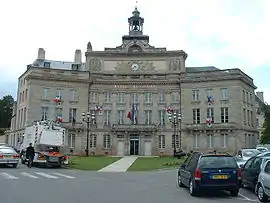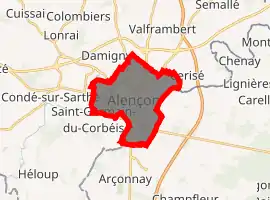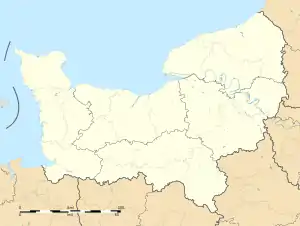Alençon
Alençon (UK: /æˈlɒ̃sɒ̃/, US: /ˌælɒ̃ˈsoʊn/, French: [alɑ̃sɔ̃] (![]() listen); Norman: Alençoun) is a commune in Normandy, France, capital of the Orne department. It is situated 173 kilometres (107 mi) west of Paris. Alençon belongs to the intercommunality of Alençon (with 52,000 people).
listen); Norman: Alençoun) is a commune in Normandy, France, capital of the Orne department. It is situated 173 kilometres (107 mi) west of Paris. Alençon belongs to the intercommunality of Alençon (with 52,000 people).
Alençon
| |
|---|---|
Prefecture and commune | |
 Town hall | |
 Coat of arms | |
Location of Alençon 
| |
 Alençon  Alençon | |
| Coordinates: 48°25′50″N 0°05′35″E | |
| Country | France |
| Region | Normandy |
| Department | Orne |
| Arrondissement | Alençon |
| Canton | Alençon-1 and 2 |
| Intercommunality | Alençon |
| Government | |
| • Mayor (2020–2026) | Joachim Pueyo |
| Area 1 | 10.68 km2 (4.12 sq mi) |
| Population (2017-01-01)[1] | 25,848 |
| • Density | 2,400/km2 (6,300/sq mi) |
| Time zone | UTC+01:00 (CET) |
| • Summer (DST) | UTC+02:00 (CEST) |
| INSEE/Postal code | 61001 /61000 |
| Elevation | 127–152 m (417–499 ft) (avg. 135 m or 443 ft) |
| 1 French Land Register data, which excludes lakes, ponds, glaciers > 1 km2 (0.386 sq mi or 247 acres) and river estuaries. | |
History
The name of Alençon is first recorded in a document dated in the seventh century. During the tenth century, Alençon was a buffer state between Normandy and the Maine regions.
In 1049–1051, William Duke of Normandy, later known as William the Conqueror and king of England, laid siege to the town, which had risen in support of the Count of Anjou along with two other towns of the Bellême estates, Domfront (then in Maine) and Bellême (held directly from King Henry I of France). According to Duke William's chaplain and panegyrist, William of Poitiers, the defenders of the fortress refused to surrender and mockingly waved animal hides from the castle walls, referencing William's lineage as the grandson of a tanner. In response to this, William had 32 prisoners of the town's hands and feet cut off, prompting a sudden surrender. Upon hearing of this event, the town of Domfront also surrendered.[2][3]
Alençon was occupied by the English during the Anglo-Norman wars of 1113 to 1203.
The city became the seat of a dukedom in 1415, belonging to the sons of the King of France until the French Revolution, and some of them played important roles in French history: see Duke of Alençon. The French Revolution caused relatively little disorder in this area although there were some royalist uprisings nearby.
A long-standing local fabric industry gave birth to the town's famous point d’Alençon lace in the 18th century. The economic development of the nineteenth century was based on iron foundries and mills in the surrounding region. In the first half of the twentieth century the city developed a flourishing printing industry.
Alençon was home to St.Marie-Azélie Guérin Martin[4] and Louis Martin,[5] the parents of St. Thérèse of Lisieux.[6] They were the first spouses in the history of the Catholic Church to be proposed for sainthood as a couple, in 2008. Zélie and Louis were married at the Basilica[7] of Notre-Dame in Alençon on 13 July 1858 and spent their whole married life in Alençon, where Thérèse was born[8] in January 1873 and spent her early childhood until the death of her mother in 1877.
On 17 June 1940 the German Army took occupation of Alençon. On 12 August 1944 Alençon was the first French city to be liberated by the French Army under General Leclerc, after minor bomb damage.
After the war the population sharply increased and new industries settled. Many of these were related to plastics and the town is now a major plastics educational centre.
Climate
| Climate data for Alençon (1981–2010 averages) | |||||||||||||
|---|---|---|---|---|---|---|---|---|---|---|---|---|---|
| Month | Jan | Feb | Mar | Apr | May | Jun | Jul | Aug | Sep | Oct | Nov | Dec | Year |
| Record high °C (°F) | 17.7 (63.9) |
19.0 (66.2) |
22.4 (72.3) |
28.9 (84.0) |
31.0 (87.8) |
35.5 (95.9) |
39.0 (102.2) |
38.5 (101.3) |
34.2 (93.6) |
28.4 (83.1) |
21.0 (69.8) |
16.5 (61.7) |
39.0 (102.2) |
| Average high °C (°F) | 7.0 (44.6) |
8.1 (46.6) |
11.6 (52.9) |
14.4 (57.9) |
18.1 (64.6) |
21.5 (70.7) |
24.0 (75.2) |
24.0 (75.2) |
20.7 (69.3) |
15.9 (60.6) |
10.6 (51.1) |
7.3 (45.1) |
15.3 (59.5) |
| Average low °C (°F) | 1.6 (34.9) |
1.4 (34.5) |
3.2 (37.8) |
4.7 (40.5) |
8.2 (46.8) |
10.9 (51.6) |
12.9 (55.2) |
12.6 (54.7) |
10.0 (50.0) |
7.7 (45.9) |
4.2 (39.6) |
2.0 (35.6) |
6.6 (43.9) |
| Record low °C (°F) | −17.4 (0.7) |
−18.0 (−0.4) |
−9.4 (15.1) |
−5.2 (22.6) |
−2.6 (27.3) |
0.3 (32.5) |
3.0 (37.4) |
2.2 (36.0) |
0.0 (32.0) |
−6.0 (21.2) |
−10.6 (12.9) |
−17.0 (1.4) |
−18.0 (−0.4) |
| Average precipitation mm (inches) | 77.1 (3.04) |
55.0 (2.17) |
57.5 (2.26) |
52.0 (2.05) |
67.5 (2.66) |
51.1 (2.01) |
55.4 (2.18) |
41.7 (1.64) |
61.8 (2.43) |
75.9 (2.99) |
68.2 (2.69) |
83.5 (3.29) |
746.7 (29.40) |
| Average precipitation days | 12.5 | 9.9 | 10.6 | 10.0 | 10.7 | 7.5 | 7.6 | 7.3 | 8.0 | 11.0 | 11.2 | 12.8 | 119.1 |
| Average snowy days | 3.8 | 3.8 | 2.8 | 1.1 | 0.1 | 0.0 | 0.0 | 0.0 | 0.0 | 0.0 | 1.3 | 2.5 | 15.4 |
| Average relative humidity (%) | 89 | 86 | 81 | 77 | 78 | 77 | 76 | 78 | 82 | 88 | 89 | 90 | 82.6 |
| Mean monthly sunshine hours | 62.0 | 85.0 | 131.4 | 163.4 | 190.3 | 217.7 | 215.0 | 212.4 | 168.2 | 113.6 | 70.5 | 60.4 | 1,689.5 |
| Source 1: Météo France[9][10] | |||||||||||||
| Source 2: Infoclimat.fr (humidity and snowy days, 1961–1990)[11] | |||||||||||||
Population
| Year | Pop. | ±% |
|---|---|---|
| 2006 | 28,458 | — |
| 2007 | 27,942 | −1.8% |
| 2008 | 27,653 | −1.0% |
| 2009 | 27,325 | −1.2% |
| 2010 | 26,704 | −2.3% |
| 2011 | 26,300 | −1.5% |
| 2012 | 26,305 | +0.0% |
| 2013 | 26,350 | +0.2% |
| 2014 | 26,028 | −1.2% |
| 2015 | 26,069 | +0.2% |
| 2016 | 26,129 | +0.2% |
 La Halle aux Blé
La Halle aux Blé Château des Ducs
Château des Ducs Library
Library
Heraldry
 Arms of Alençon |
The arms of Alençon are blazoned : Azure, a double-headed eagle displayed Or. |
Economy
In the seventeenth century, Alençon was chiefly noted for its lace called point d'Alençon.
Today, Alençon is home to a prosperous plastics industry, and, since 1993, to a plastics engineering school.
MPO Fenêtres is a local PVC windows company established in Alençon since 1970, is one of the first company in Alençon with around 170 employees (2009) and a turnover of 28 million euros in 2008. It is also the oldest French PVC windows company still in activity.
Education
"Écoles". Archived from the original on 2 April 2015. Retrieved 3 March 2015.
"Collèges". Archived from the original on 2 April 2015. Retrieved 3 March 2015.
"Lycées". Archived from the original on 2 April 2015. Retrieved 3 March 2015.
Transport
Alençon is linked by the A28 autoroute (motorway/freeway) with the nearby cities of Le Mans to the south (Sarthe) and Rouen (Seine-Maritime) to the north.
The A88 autoroute links the A28 just north of Alençon to the coastal port of Caen.
A comprehensive town bus system operates from 7:00 to 19:00.
There is a comprehensive network of cycle paths.
Personalities
Alençon was the birthplace of:
- Anne d'Alençon (1492–1562), marquise of Montferrat ;
- Marie-Catherine de Villedieu, (1640–1683), novelist
- Pierre Allix (1641–1717), Protestant pastor and author
- Léonard Bourdon (1754–1807), Revolutionist
- Jean Castaing (playwright) (1723–1805), printer, playwright
- Louis de Frotté, dit « Blondel » (1766–1800), chouan general
- Edme Castaing (1796–1824), doctor and murderer
- Jacques Hébert (1757–1794), editor of the extreme radical newspaper Le Père Duchesne during the French Revolution
- Jacques-Julien Houtou de Labillardière (1755–1834), botanist
- Juste Lisch (1828–1910), architect
- Raoul Le Mouton de Boisdeffre, 1839–1919, general
- Éléonore-Aglaé-Marie Despierres (1843–1895), historian
- Adolphe Gérard (1844–1900), American restaurateur
- Adhémar Leclère (1853–1917), author
- Thérèse de Lisieux (1873–1897), Roman Catholic nun who was canonised as a saint,[6] and is one of only 33 Doctors of the Church
- Auguste Poulet-Malassis (1825–1878), publisher and friend of Baudelaire
- Marie-Azélie Guérin Martin[4] (1831–1877), the mother of St. Thérèse of Lisieux who, along with her husband Louis Martin,[5] is one of the few married couples ever to be beatified by the Catholic Church.
- Daniel Balavoine (1952–1986), singer and songwriter
- Louis Barillet (1880–1948), glass blower
- André Couder (1897–1979), astronomer
- Alain Lambert (1946–), politician
- Anne Consigny (1963–), actress
- Yoann Chivard, dit « Yoann », (1971–), graphic artist
- Laurence Leboucher (1972–), female cyclist
- Lorànt Deutsch (1975–), actor and writer ;
- Benoît Tréluyer (1976–), car racer, two-time winner of the Le Mans 24 Hours
- Jonathan Cochet (1976–), car racer
- Anthony Geslin (1980–), cyclist
- Orelsan (1982–), rapper
- Arnold Mvuemba (1985–) footballer
International relations
 Basingstoke, England, United Kingdom
Basingstoke, England, United Kingdom Quakenbrück, Germany
Quakenbrück, Germany
References
- "Populations légales 2017". INSEE. Retrieved 6 January 2020.
- The Gesta Normannorum Ducum of William of Jumièges, Orderic Vitalis and Robert of Torigni, ed. and trans. E. van Houts, 2 vols (Oxford, 1992–95) vol. 2 p. 125
- https://www.history.com/news/10-things-you-may-not-know-about-william-the-conqueror
- "Shrine Louis and Zelie Martin (Alençon-France) - Zelie Martin's life". Archived from the original on 15 March 2014. Retrieved 16 March 2014.
- "Shrine Louis and Zelie Martin (Alençon-France) - Louis Martin's life". Archived from the original on 15 March 2014. Retrieved 16 March 2014.
- "Shrine Louis and Zelie Martin (Alençon-France) - St. Therese's life". Archived from the original on 15 March 2014. Retrieved 16 March 2014.
- "Shrine Louis and Zelie Martin (Alençon-France) - The basilica of Notre Dame". Archived from the original on 15 March 2014. Retrieved 16 March 2014.
- "Shrine Louis and Zelie Martin (Alençon-France) - Alençon, the birthplace of St. Therese". Archived from the original on 15 March 2014. Retrieved 16 March 2014.
- "Données climatiques de la station de Alençon" (in French). Meteo France. Retrieved 9 January 2016.
- "Climat Basse-Normandie" (in French). Meteo France. Retrieved 9 January 2016.
- "Normes et records 1961-1990: Alençon - Valframbert (61) - altitude 144m" (in French). Infoclimat. Retrieved 9 January 2016.
- "Jumelages". alencon.fr (in French). Alençon. Retrieved 18 November 2019.
External links
| Wikivoyage has a travel guide for Alençon. |
| Wikimedia Commons has media related to Alençon. |
- Official town website
- Alençon Tourist Office
- Shrine of Alençon : pilgrimage on the steps of St. Therese and her parents, the blessed Louis and Zelie Martin
- Web site about the life, writings, spirituality, and mission of St. Therese of the Child Jesus of the Holy Face, who was born in Alencon on 2 January 1873; information about the life of her family in Alencon and about pilgrimages to Alencon
- Alencon's citizen portal